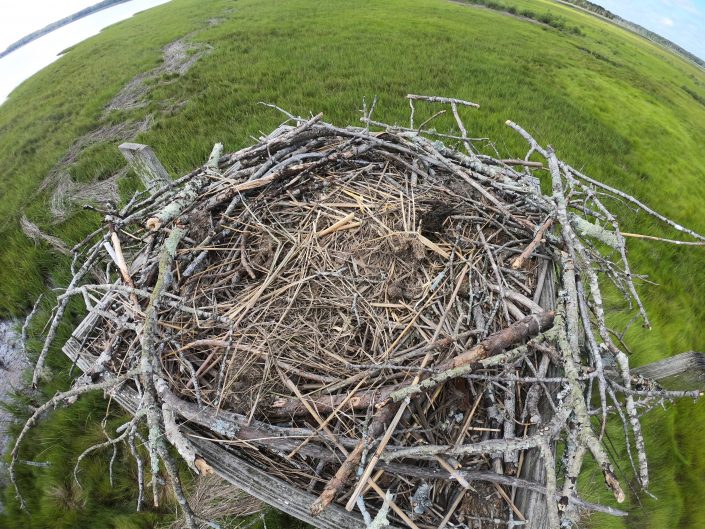Nor’easter and Prey Shortage Impacts Nesting Ospreys in 2023
by Ben Wurst / Senior Wildlife Biologist

In coastal New Jersey, during spring and summer the recovery of ospreys is apparent. They grace the skies of most ocean front beaches from Sandy Hook to Cape May in search of prey. Their nests line our shorelines and can be found in a variety of nest structures. Today there are over 800 pairs of ospreys who nest all across New Jersey. Results from the 2023 nesting season illustrate how the osprey population continues to grow but with reduced reproductive success due to extremes in weather and reduced prey availability.

I never thought I would have to respond to so many concerned citizens about osprey nestlings that were left alone in nests, some to starve to death. I then watched online as a few nestlings fell from their nest and died or battled with siblings over prey brought into their nests. This is a brief summarization of my summer last year, where the widespread occurrence of brood reduction was playing out, which is a natural adaptation to account for variations in food availability. It helps ensure that when food is limiting, the strongest nestling(s) have a better chance of surviving to fledge. Nature is cruel and it is hard to watch. I never thought I would see brood reduction play out like it did.
As reported last year, ospreys faced one of their toughest years, due to a nor’easter which impacted the coast in mid-June. This weather system, which is quite common, came during the nestling period, when osprey young are flightless and need a lot of food to survive. It was terrible timing, as the stiff onshore winds, precipitation and associated wave action made it very difficult for adult male ospreys to find and catch prey. This resulted in many nestlings dying of starvation during the storm and afterwards, as a key prey species, specifically Atlantic menhaden, was not as abundant. This was evident in results of our surveys which found that two thirds of all colonies had reduced productivity, which is a measure of the health of the population.

Through surveys conducted by staff and our corps of dedicated volunteers and partners we surveyed 808 occupied nests. We were able to determine the outcome of 79% of these nests (657). Those osprey pairs produced a total of 762 young, for a productivity rate of 1.16 young/known-outcome nest. Just over 200 pairs that laid eggs failed to produce young that fledged — a 32% failure rate. One hundred forty-four nestlings were banded for future tracking and 50 banded ospreys were re-sighted or encountered in 2023.

Even though it wasn’t a great year, results from our surveys were more accurate, given the fact
that many included follow up surveys to learn true outcomes at nests. Overall population stability, and banding and encounter data suggests ospreys live long, productive lives, and there may be “extra” adults who are present and not currently nesting. Nest platforms are being better maintained to support a stable population, but the food resources must be there to maintain it.
We can’t thank all of our donors, volunteers and partners for their efforts to help us monitor and manage a stable osprey population in New Jersey. Click on the link below to read full results in our 2023 New Jersey Osprey Project Report.
>> Read full results in our 2023 New Jersey Osprey Project Report
Discover more from Conserve Wildlife Foundation of NJ
Subscribe to get the latest posts sent to your email.